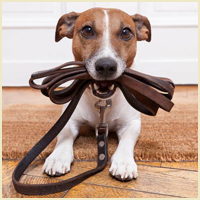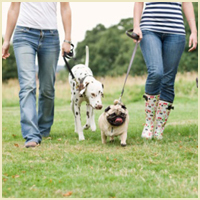 There’s something relaxing about walking dogs for both parties. We get out in the fresh air for exercise with our best pal with the possibility of seeing something cool or at least interesting, along the way. Burner and I came around a corner in the woods one day face to face with a hawk and his recent lunch catch. He spread his wings wide and screamed at us – Burner and I looked at each other, and slunk back the way we had come, hoping he wouldn’t chase us away… very cool thing to see!
There’s something relaxing about walking dogs for both parties. We get out in the fresh air for exercise with our best pal with the possibility of seeing something cool or at least interesting, along the way. Burner and I came around a corner in the woods one day face to face with a hawk and his recent lunch catch. He spread his wings wide and screamed at us – Burner and I looked at each other, and slunk back the way we had come, hoping he wouldn’t chase us away… very cool thing to see!
Walking is one of the best exercises available, especially to starting dog rehabilitation. If the animal needs rehab for a leg injury, or a leg is weak from a neurologic process, slow walking can be a great benefit. The slowness encourages each limb to land and bear weight throughout the range of motion. If the dog is reluctant to bear weight on the injured limb, going slowly allows him to do so gradually, and allows us to praise him for doing so, in effect, retraining him how to walk correctly. The slower we walk, the more weight-bearing is accomplished on the problematic limb. The more a limb is used as it heals (within reason) the faster strength returns, and the more correctly the tissues heal. As the dog gains confidence with slow walks, and is able to move normally, the speed can be increased to challenge balance, nerve function, and coordination, as well as add some cardio to the session.
 After the dog is comfortable with fast walks, we often add in several speed transitions, or changes of pace. Transitions require balance and swift muscular control in order to be correct and graceful. In sport training, dogs have to practice speed changes at work before they look sharp and controlled. Once transitions have been added to the routine, we can further challenge the animal by gently pushing them and requiring them to prevent themselves from loosing balance. This also has the added benefit of recruiting core muscles for some mild strength training.
After the dog is comfortable with fast walks, we often add in several speed transitions, or changes of pace. Transitions require balance and swift muscular control in order to be correct and graceful. In sport training, dogs have to practice speed changes at work before they look sharp and controlled. Once transitions have been added to the routine, we can further challenge the animal by gently pushing them and requiring them to prevent themselves from loosing balance. This also has the added benefit of recruiting core muscles for some mild strength training.
Further challenges can be had by walking uphill. This will require more strength and effort by the rear limbs to propel the dog up the incline. Going downhill recruits more effort by the front end for braking and directional control, as well as requiring the hind limbs to reach further beneath the body, increasing the flexion of the rear joints.
Animal rehab does not always have to be about fancy machines and exotic workouts. The thoughtful use of a walk in the woods can be just as good during some early stages of therapy. The next time you walk your dog, take him up and down hills, and over branches and tree roots. Watch the differences in the way he moves his limbs – the effortless changes of a healthy, fit dog are really fun to see!

Recent Comments